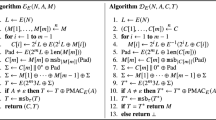Abstract
In this paper we cryptanalyse a block cipher mode of operation, called Input Output Chaining (IOC), designed by Recacha and submitted to NIST in 2013 for consideration as a lightweight authenticated encryption mode. We present an existential forgery attack against IOC which makes only one chosen message query, runs in a small constant time, and succeeds with an overwhelming probability 1 - 3 × 2− n, where n is the block length of the underlying block cipher. Therefore, this attack fully breaks the integrity of IOC.
Access this chapter
Tax calculation will be finalised at checkout
Purchases are for personal use only
Preview
Unable to display preview. Download preview PDF.
Similar content being viewed by others
References
Authenticated Encryption Modes. National Institute of Standards and Technology, http://csrc.nist.gov/groups/ST/toolkit/BCM/modes_development.html#01
ISO/IEC 19772:2009: Information technology – Security techniques – Authenticated encryption. International Organization for Standardization, Geneva, Switzerland (2009)
Bellare, M., Namprempre, C.: Authenticated Encryption: Relations among Notions and Analysis of the Generic Composition Paradigm. In: Okamoto, T. (ed.) ASIACRYPT 2000. LNCS, vol. 1976, pp. 531–545. Springer, Heidelberg (2000)
Bellare, M., Namprempre, C.: Authenticated Encryption: Relations among Notions and Analysis of the Generic Composition Paradigm. J. Cryptology 21(4), 469–491 (2008)
Bellare, M., Rogaway, P.: Encode-Then-Encipher Encryption: How to Exploit Nonces or Redundancy in Plaintexts for Efficient Cryptography. In: Okamoto, T. (ed.) ASIACRYPT 2000. LNCS, vol. 1976, pp. 317–330. Springer, Heidelberg (2000)
Bernstein, D.J.: Cryptographic competitions: CAESAR, http://competitions.cr.yp.to
Canvel, B., Hiltgen, A.P., Vaudenay, S., Vuagnoux, M.: Password Interception in a SSL/TLS Channel. In: Boneh, D. (ed.) CRYPTO 2003. LNCS, vol. 2729, pp. 583–599. Springer, Heidelberg (2003)
Katz, J., Yung, M.: Unforgeable Encryption and Chosen Ciphertext Secure Modes of Operation. In: Schneier, B. (ed.) FSE 2000. LNCS, vol. 1978, pp. 284–299. Springer, Heidelberg (2001)
Kohl, J.T.: The use of Encryption in Kerberos for Network Authentication. In: Brassard, G. (ed.) CRYPTO 1989. LNCS, vol. 435, pp. 35–43. Springer, Heidelberg (1990)
Krovetz, T., Rogaway, P.: The software performance of authenticated-encryption modes. In: Joux, A. (ed.) FSE 2011. LNCS, vol. 6733, pp. 306–327. Springer, Heidelberg (2011)
Menezes, A., van Oorschot, P.C., Vanstone, S.A.: Handbook of Applied Cryptography. CRC Press (1996)
Mitchell, C.J.: Cryptanalysis of Two Variants of PCBC Mode When Used for Message Integrity. In: Boyd, C., González Nieto, J.M. (eds.) ACISP 2005. LNCS, vol. 3574, pp. 560–571. Springer, Heidelberg (2005)
Mitchell, C.J.: Analysing the IOBC Authenticated Encryption Mode. In: Boyd, C., Simpson, L. (eds.) ACISP. LNCS, vol. 7959, pp. 1–12. Springer, Heidelberg (2013)
Preneel, B.: Cryptographic Primitives for Information Authentication - State of the Art. In: Preneel, B., Rijmen, V. (eds.) State of the Art in Applied Cryptography. LNCS, vol. 1528, pp. 49–104. Springer, Heidelberg (1998)
Recacha, F.: IOBC: Un nuevo modo de encadenamiento para cifrado en bloque. In: Proceedings: IV Reunion Espanola de Criptologia, Valladolid, pp. 85–92 (September 1996)
Recacha, F.: IOC: The Most Lightweight Authenticated Encryption Mode? National Institute of Standards and Technology, Modes Development, Proposed Modes (April 2013), http://csrc.nist.gov/groups/ST/toolkit/BCM/modes_development.html
Recacha, F.: Input Output Chaining (IOC) AE Mode Revisited (January 2014), http://inputoutputblockchaining.blogspot.ch/
Vaudenay, S.: Security Flaws Induced by CBC Padding - Applications to SSL, IPSEC, WTLS... In: Knudsen, L.R. (ed.) EUROCRYPT 2002. LNCS, vol. 2332, pp. 534–546. Springer, Heidelberg (2002)
Author information
Authors and Affiliations
Editor information
Editors and Affiliations
Rights and permissions
Copyright information
© 2014 Springer International Publishing Switzerland
About this paper
Cite this paper
Bottinelli, P., Reyhanitabar, R., Vaudenay, S. (2014). Breaking the IOC Authenticated Encryption Mode. In: Pointcheval, D., Vergnaud, D. (eds) Progress in Cryptology – AFRICACRYPT 2014. AFRICACRYPT 2014. Lecture Notes in Computer Science, vol 8469. Springer, Cham. https://doi.org/10.1007/978-3-319-06734-6_8
Download citation
DOI: https://doi.org/10.1007/978-3-319-06734-6_8
Publisher Name: Springer, Cham
Print ISBN: 978-3-319-06733-9
Online ISBN: 978-3-319-06734-6
eBook Packages: Computer ScienceComputer Science (R0)




